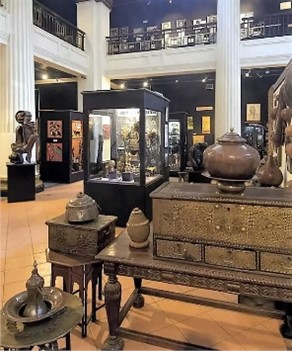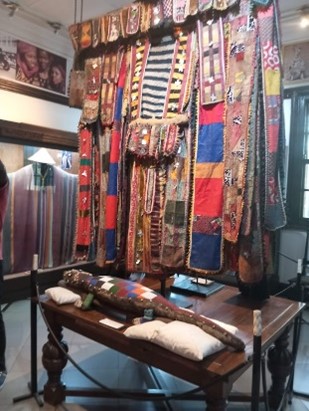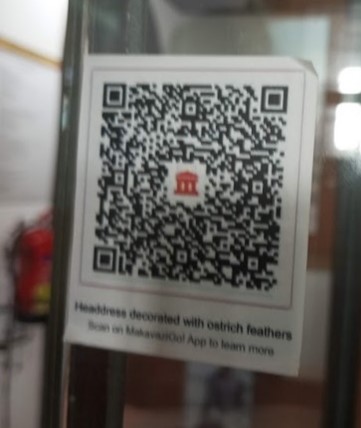MANAGEMENT
The Nairobi Gallery is commonly known as Joseph Murumbi House is under the management of the National Museums of Kenya. The building is a national monument hosting numerous exhibitions of works by both foreign and local artists, it is part of the historical Kenya safari of the city of Nairobi.
WHY NAIROBI GALLERY?
The formidable structure of the building is most certainly an undervalued piece of Kenyan history and culture. The building is situated at Kenya’s point zero from where distances to all corners of the country and subsequently to the continent and the world were measured from. Further, the building is part of an original master plan of government buildings around what is now Kenyatta Avenue.
The building is in many ways connected to the history and development of Nairobi and its people. Built in 1913, to house the Native Ministry, this building was fondly referred to by the settler community as ‘Hatches, Matches and Dispatches’ because of the births, marriages and deaths that were recorded there. Before independence, the building was a colonial courthouse where natives accused of entering Nairobi without a pass were tried and sentenced.
HISTORY
From a narration from my guide, JOSEPH ZUZARTE MURUMBI was born in Kenya in 1911, from a Goan father and Maasai mother, the daughter of Murumbi, the Maasai Laibon (political leader) for the Uasin Gishu Maasai. His father had arrived in Kenya in 1897 at the time the first railway was just entering the area where Murumbi was later born.
Joseph was married to Sheila Murumbi and were among Africa’s most famous private collectors.
The building, named after this famous gentleman, was designed by C. Rand Ovary and the construction completed in 1913 for the Ministry of Native Affairs. During colonial times, it served as a government office that would have the function of counting marriages, births and deaths. From 1963, the building was used as the Provisional Commissioner’s office until 1984. The building was later used as Kanu’s branch office in Nairobi until 1997. In 1995, the building was declared a national monument, and the ownership of the building was passed to the National Museums of Kenya in 1997. In 1999, the state corporation began the process of renovating the building. The renovation work was completed in 2005 and the gallery opened for the first time.
HOW TO GET THERE
It is located at Kenyatta Avenue and Uhuru Highway roundabout next to Nyayo House in the heart of Nairobi CBD. It is accessible by road, using a car, motorcycle or walking.
WHEN TO GET THERE
The gallery is accessible daily from 0830Hrs to 1730Hrs EAT.
ACTIVITIES AT THE GALLERY
- Guided Tours: Individuals/groups can enjoy guided tours by well-trained guides who interpret the exhibition
- Photo taking: Every area at the gallery is permissible to take photos.
ENTRANCE FEES AT NAIROBI GALERY
Kenyan citizens only need to have KES 150 for entry while residents and non-residents need KES 600 and 1000 respectively. Payments are only made via e-citizen account.
WHAT MAKES THE PLACE STAND OUT
- The Collections
The gallery has a collection of pan-African stamps from different countries of the continent as well as a collection of Joseph Murumbi’s photos. In the “Joseph and Sheila Murumbi’s Room”, there are several pieces of furniture such as a Lamu sofa, a Zanzibar cupboard and posters about African heritage. The gallery also contains African jewellery, part of which belongs to the Turkana culture. In addition, the gallery contains African stools, traditional weapons, and containers used by different Kenyan communities for storage or cooking.

Nubian baskets and wood carvings can be found in the gallery as well.

Sculptures and paintings by artists from different parts of Africa such as Nigeria with works by Bruce Onokbrakpeya, Joseph Olabode and Asiru Olatunde Osogbo are housed in the gallery. The gallery also contains traditional clothing such as Egunguns and traditional textiles such as a collection of kangas.
- Continued Improvement & Exhibits at the Gallery
- In 2015, the gallery showed work by Kenyan artist Peterson Kamwathi.
- In 2018, the gallery organized an exhibition featuring works by nine East African women artists, including artwork by Margaret Trowell, Rosemary Karuga, Magdalene Odundo, Theresa Musoke, Robin Anderson, Yony Wait-e, Joy Adamson, Geraldine Robarts and Nani Croze.
- In 2019, the gallery exhibited Tinga Tinga paintings which originated in Tanzania.
- In the same year, the gallery presented an exhibition with artists from Tanzania that included works by artists Robina Ntila and Muzu Suleiman
- A Colonial safe
The Nairobi Gallery has an old safe that was used by the colonial government and has never been opened since they left. The whereabouts of the keys are unknown, resulting to a belief that the colonial masters left with the keys.
- Point Zero
The original entrance of the building leads to a point zero location from where all the distances to all corners of the country are measured. (The black spot at the Centre is point zero.)
- Adoption of Tech

In 2019, the National Museums of Kenya collaborated with Google to digitize the Nairobi gallery’s exhibits to the Google Arts & Culture platform as well as add an adapted version of Google Street View to the museum’s rooms.
For every item being showcased, there is a QR code with more information.
- Security Measures for Safe-Guarding the Artefacts
While it is common in galleries that artefacts are stolen by visitors and sometimes stolen by the staff. At this facility, there is a 24-hour alarm system that safeguards some of the expensive exhibits like coins and chains of different makes and materials. Once someone touches an alert system is triggered that can only be turned off by authorized staff members using their biometrics.
SUSTAINABILITY RATING
Environmental consciousness
I would rate the facility an 8 out of 10. The trail is relatively short, which means visitors don’t spend too much time there, reducing the likelihood of littering. Furthermore, there are trash bins available for disposing of waste. The National Museums of Kenya staff consistently maintains cleanliness both within the facility and around the compound.
The facility currently lacks meaningful socio-economic sustainability initiatives. All revenues generated by the facility are directed to the National Treasury, and decision-making regarding improvements and new initiatives is centralized at the National Museums of Kenya Headquarters.
Review by Michael Mugendi, Student at Dedan Kimathi University of Science and Technology.


Leave a comment